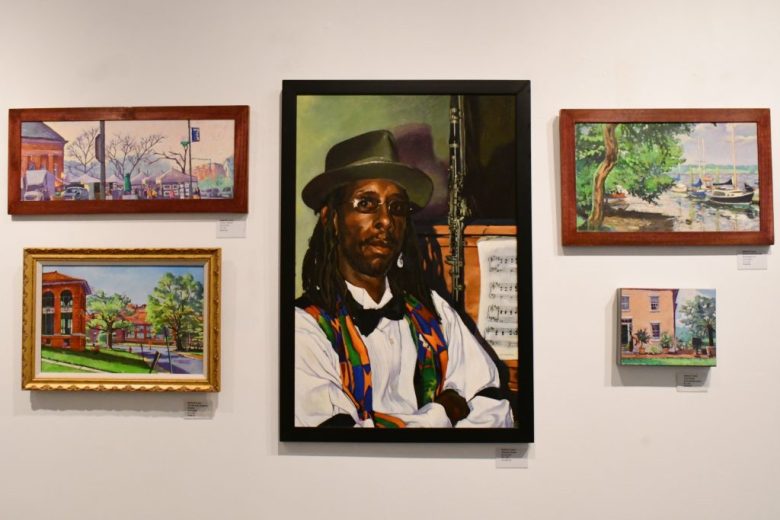Painting is so integral to local artist Roderick Turner’s life that you’ll hardly ever find him not working on his art. Even in mid-conversation, it’s likely he’ll pull out his supplies and begin a new project—something he did while speaking with City Paper for this article. Sitting on a bench inside Foundry Gallery, where staff prepared for the artist’s opening reception scheduled for the following hour, Turner, pencil in hand, placed a sketch pad on his lap and a bag full of paints on the ground next to his feet.
“I like to work while I talk,” he tells City Paper. “When you’ve been an artist as long as I have, multitasking comes easy to you. I’m always thinking of a new idea.”
Turner may not have been born in D.C., but he’s lived here long enough to know the city as well as any native. Ever since the visual artist moved here in the 1980s for school and the opportunity to work on murals, he has been painting the city as he sees it—the good and the bad—with a particular focus on Southeast neighborhoods. Turner’s decades-long work to document D.C. has culminated in Life in DC, which is on display at the Foundry through June 2.
“I came up with the title because I’m trying to show the city’s treasure, past and present, in this show,” he says. “It’s all about bringing attention to what we have here in the city—not so much the major landmarks but rather the subtle things in this ever-changing place.”
Besides a single, large portrait of an “unknown pianist,” Life in DC consists of cityscapes in three different styles: watercolor, acrylic, and oil painting. But these pieces are not mere depictions of city skylines—they’re stories of change. Many of the works on display focus on the same locations at the same angles, but at different time periods. What might look like glimpses of uneventful moments in time are recontextualized when viewed together, revealing years of gradual gentrification.
In one series of five paintings, Turner documents 9th Street in Southeast as it was in 2000 (a mostly tree-filled, scenic stretch of road) and the gradual construction that took place until the street became an urban neighborhood with multistory housing. In another series of paintings, Turner documents in acrylics how the city’s wharf looked when he first arrived here in the 1980s, with docks displaying a replica of the Amistad. In more recent watercolor paintings, he shows how the ship and simple docks have been replaced with modern buildings and grand architecture, centering on the neighborhood’s main attractions such as the Anthem.
“In D.C., we’re dealing with gentrification, which means neighborhoods are changing and people are getting pushed out,” Turner says. “I want to show people that the way these areas look is important.”
He continues, “It might be no big deal to you now but your children and their children will want to see how the city used to look. That’s what I’m providing for them here.”
The inspiration behind painting D.C. over the span of decades came from his time spent in France. In 1993, Turner traveled to Giverny for a four-month artist residency. There, he observed how French impressionists such as Claude Monet painted their own cities and began to think that not enough artists were doing that for D.C. Turner wants his art to document change but also highlight the unique culture of the city.

“These paintings are my story—my visual journal,” he says. “To some people they might seem like paintings of buildings and urban scenes, but not to me. The more you stay and look, you’ll see there’s a story within them.”
But Turner has found it increasingly difficult to be a painter in D.C. as the years have passed. He says hardly anyone questioned him when he first moved here, yet now there are times when he has to show a permit to authorities just so he can paint outside. Despite facing more obstacles today, Turner’s dedication to documenting his home means he has no intention of ever stopping—or leaving.
“I’ll keep painting D.C. as long as I can,” he says. “It’s important for people to recognize what they have because if you don’t, then you’ll end up … not valuing it. When you start embracing and being thankful for what you already have, it makes you appreciate it more and take care of it a little better.”
“I’ve witnessed so many stories here and there are still more that need to be captured,” he says.
Roderick Turner hosts a watercolor workshop at 3 p.m. on May 18 and gives an artist talk starting at 4 p.m. on May 25 at Foundry Gallery, where Life in DC runs through June 2. foundrygallery.org. Free.